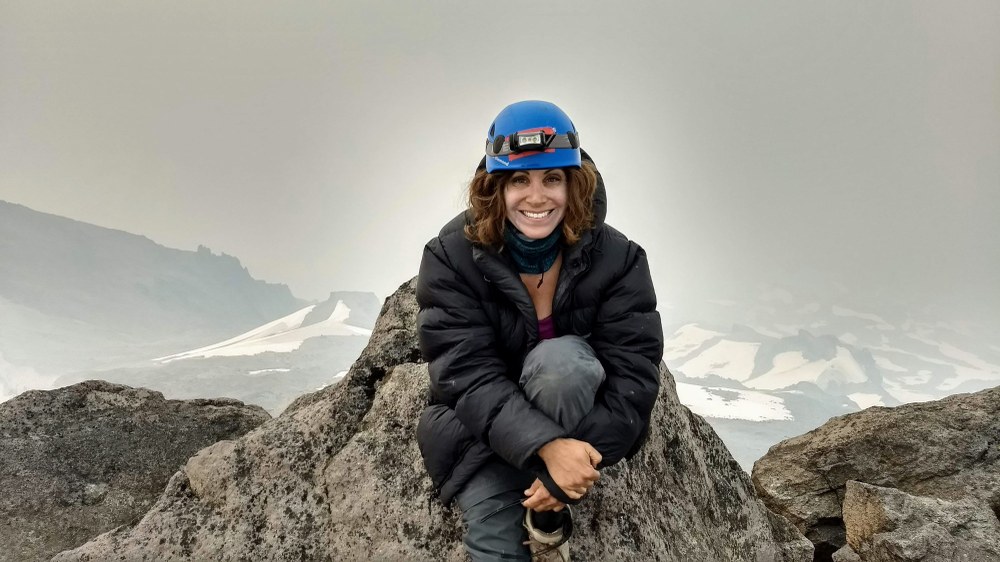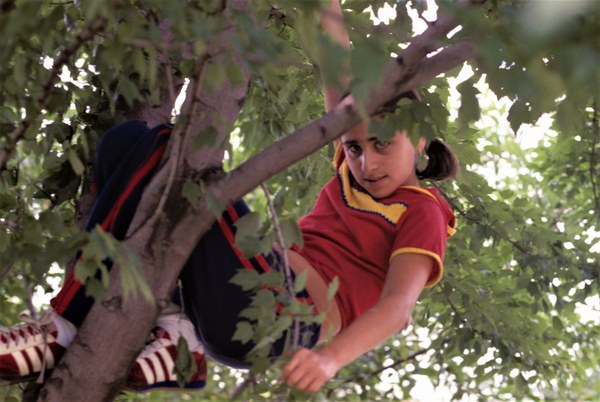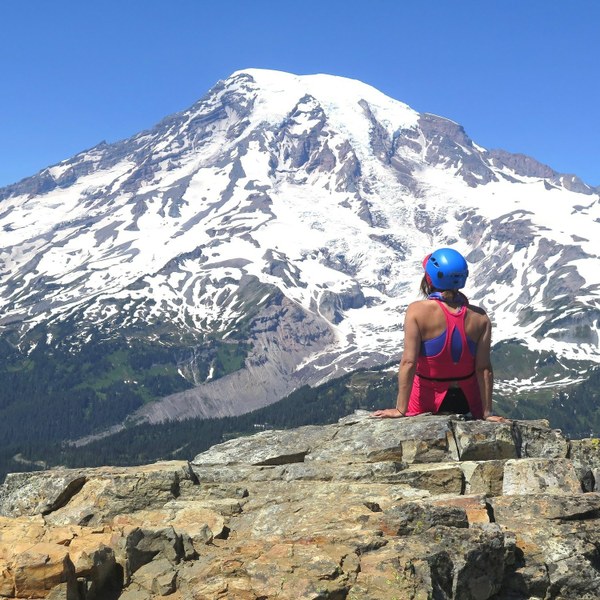
My success as a climber was far from guaranteed.
Growing up Jewish, an ethnicity stereotyped as bookish and non-athletic, I struggled with scoliosis, a lazy eye, orthotic shoes, and a disability that impairs hand-eye (brain) coordination. In my urban Los Angeles elementary school, our “special” PE class endured taunts of “Retard PE!” from the “normal” kids. Add on teenaged depression/anxiety, an eating disorder, lifelong PTSD - in part from childhood bullying - and a bit of confusion (self-judgment) around gender and orientation, and I felt like a freak.
Not once did I think to find solace in the outdoors, much less to climb mountains.
The climbing bug bit in 2010, at the tender (ripe?) age of 41. My mother had died after a long decline, and a friend invited me up Mt. St. Helens. The climb took 12 sweaty hours, and I spent the descent crying, moaning, and finally whimpering. That night I swore, “Never again!”
The following spring a friend suggested Mt. Adams. He advised me to train, a tough order since my health had tanked after my mother’s death. But I grimaced and whined through progressively harder hikes, and we summited on a bluebird morning in 2011. Back at Lunch Counter, I fumbled around, shivering in my puffy on a 70-degree day. My friend recognized Acute Mountain Sickness (AMS) and took me down.
 Climbing for a little alone time in the summer of 1979. Photo by Macey Lipman.
Climbing for a little alone time in the summer of 1979. Photo by Macey Lipman.
‘Cat-Man’ and ‘Cattle Prod’
Not to be beaten, I set my sights on Mt. Hood. I joined a local climbing club in Oregon and received training, but also found sexism, ageism, and able-ism.
My climbing instructor sat me down after snow class and asked if I was “slow” (mentally and physically) because I was older, or female. Infuriated, I told him I knew why he lived alone with a cat.
There was an instructor I called Cattle Prod, who hiked behind me with my 40lb pack and told me no one would want me on climbs if my pace was this slow. I asked his wife if his life insurance was up to date.
That summer I climbed Mt. Hood with guides. A fellow climber mansplained for seven hours. I climbed faster to minimize our time together.
But I loved climbing. The otherworldly terrain of rock, snow, and fumaroles. The approaches through magical forests. The leg-burning effort. The sunrise and summit shadow. The smell of the wind. The elated feeling of topping out. The scrumptious meal and warm bed after. Even the cold, tired descent.
Someone to believe in me
In time I came to love the people as well. An assistant leader from my club, a woman named Amy, heard about my unfortunate chat with the cat guy. She invited me on the Mother’s Day climb of St. Helens because, she said, “You need to know that this stuff can be fun.” There were skiers and snowboarders in church dresses and bonnets, and one in a blinding disco-ball mini. It was fun. Amy pointed out cornices, avalanche slopes, and route finding issues. She eventually became a leader with that club and helped shift its culture. And her confidence got me up Broken Top, Mt. Washington (Central Oregon), and Mt. Rainier.
While my early stories demonstrate issues in our sport, every climber, guide, or instructor I met helped make me the climber I am. Every leader I loved and emulated, and every leader who rejected me (sometimes the same person) helped make me the leader I am. My attitude of encouragement and inclusion is a tribute to Amy, but also to Cat-Man and Cattle Prod.
A few tipping points
When I moved to Olympia, a friend suggested I review The Mountaineers Basic Climbing Course. The atmosphere was welcoming and evolved. A smart progression took members from hiking to scrambling to climbing. And, while the club is not perfect, I’ve only been talked down to twice and creeped upon once, and I was relieved to find allies in our branch leadership.
Privately, I pursued high altitude dreams, where I noticed colonialism on Kilimanjaro and Cayambe. When I trekked in Nepal, I saw Sherpas climbing 10 times for every white climber’s summit, with greater risk and less recognition.
Simultaneously, my employer, a public lands agency, began exploring diversity in the Washington outdoors. Across races, income levels, sexual and gender identities, religions, and fitness levels, many felt unwelcome in our state and national parks.
Research was also coming out about the health benefits of the outdoors. Lack of access and lack of welcome kept marginalized people on the sidelines of health and well-being.
I was heartened, however, by the explosion of young people on Instagram framing this conversation.
 Private scramble of Pinnacle Peak - July 2018 Photos by Josephine Johnson
Private scramble of Pinnacle Peak - July 2018 Photos by Josephine Johnson
New voices, new glasses
Following The Mountaineers on social media and joining the Equity & Inclusion Committee, I wondered if my voice mattered.
Indeed, my own biases needed management: the tendency to over-welcome hikers or climbers of color, my sometimes misgendered pronouns, my assumption that plus-sized climbers were hikers, my spotty acknowledgment of Native lands.
In the Olympia branch, these discussions united a group of leaders who became sensitive to inclusion. The terms “No hiker left behind,” and “No screw-you breaks” embedded into our language. We help slow hikers and scramblers rethink their progression, and we try not to make anyone feel bad on our trips.
Our core group includes millennials, gen xers, and boomers; cisgender and non-binary people of several religions and orientations; folx on the autism spectrum; plus-sized leaders; leaders who fight physical and mental illnesses; and leaders who live with disabilities. We recognize that diversity is vast, and exclusion takes many forms. People often feel bad about themselves in their work, family, or social structures; we don’t need to feel inadequate or “other” on weekends and in the outdoors.
On my own Instagram (@skygypsy7), I hashtag #WeBelongOutside. Because we all bring something unique. Whether it’s a voice for oppressed populations, or an ability to see a route before it’s been set… Whether it’s a push toward high-altitude fitness, or encouragement for the scrambler who didn’t think they could summit St. Helens, every contribution matters.
Yes, I deal with impostor syndrome. I still see myself as that kid in special PE, the depressed high-schooler locked in her room. I still get looks from Jewish friends, because, “Are you crazy?”. My peculiar brain requires me to re-learn belays and coils each year, and I’ll never win any speed races. I feel a little too old to join the cadre of influencers shaping this movement. And last summer I spent three days leading Glacier Peak, constantly questioning myself after my mentoring leader took a sick climber down. (The remaining students and I summited, which still makes me tear up.)
I’m grateful to The Mountaineers for developing my skills, growth, leadership, and self-confidence in a warm, toasty incubator, and for handing me a new set of glasses through which to see myself and the world. In my humble opinion, this is available to every Mountaineer who wants it. Climb on!
This article originally appeared in our Summer 2019 issue of Mountaineer Magazine. To view the original article in magazine form and read more stories from our publication, click here.
Add a comment
Log in to add comments.Thanks, Meryl. This is awesome. I like "no hiker left behind." While the idea has been part of the holes I lead. I hadn't heard that formula before.
 Meryl Lassen
Meryl Lassen